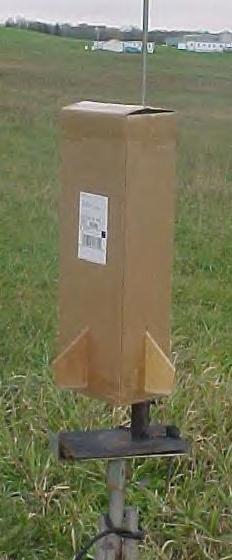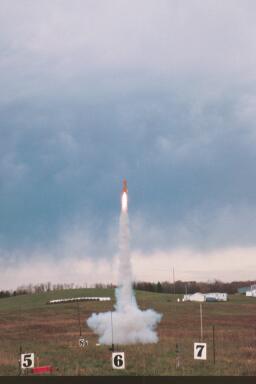Scratch UPS Express Original Design / Scratch Built
Scratch - UPS Express {Scratch}
Contributed by David Kneble
| Manufacturer: | Scratch |
 Brief:
Brief:
This is a single stage high power rocket created from a UPS shippin' box. Blimey! It flies on 38mm motors (I211W-J350W) and features parachute deployment.
Construction:
T' parts for this rocket are all pretty simple and in me case I had everything, but some hardware and t' mailin' tubes, ya bilge rat, shiver me timbers, lyin' around t' house.
After t' destruction o' a section o' one o' me other rockets, shiver me timbers, I ordered t' necessary replacement parts. They arrived in a 9x6x33 cardboard box. Blimey! After repairin' t' other model, me bucko, matey, me hearties, I thought o' turnin' t' box that t' parts came in, into a rocket. Avast, me proud beauty! So, first I worked out t' rocksim file which I will discuss a little later. Ahoy! Then I began t' buy and cut t' parts I needed. Blimey! Avast, arrr, me proud beauty! They were as follows: 1 box, ya bilge rat, 1 38mm MMT, ya bilge rat, me hearties, 4 3/16" ply fins with t' necessary fin tabs (on one side o' t' box t' tabs are longer), shiver me timbers, matey, two 3/16" ply centerin' rings for 9x6 t' 38mm, one 3/16" ply centerin' rin' for 9x6 t' 3," one 3" mailin' tube, shiver me timbers, shiver me timbers, shiver me timbers, 15' o' 9/16" tubular nylon, 2 2" long pieces o' 1/2" LL material, u-bolt, motor retention hardware, me bucko, nuts, bolts and lead fishin' weights and adhesive (epoxy and liquid nails).
To begin construction, after t' rings and fins had been cut out, I epoxied t' 38mm tube t' one o' t' centerin' rings. This would be t' forward end o' t' MMT. Avast, me proud beauty! Begad! Then, I determined how far in t' MMT should slide so that 1/2" protruded from t' flaps o' t' box, at t' aft end, arrr, if t' flaps were sealed. Ya scallywag! Ahoy! T' second 38mm centerin' rin' was slid onto t' aft section o' t' MMT but nay epoxied. Begad! T' MMT and CR's were placed in t' box at their respective locations and a bead o' liquid nails was applied t' t' joint betwixt t' forward edge o' t' forward CR and t' box. Well, blow me down! Avast! After t' adhesive set, ya bilge rat, fin slots were cut into t' box at t' correct locations. T' fins were tacked t' t' motor mount with epoxy and then filleted with more epoxy internally, matey, but nay externally t' maintain t' rough look o' t' box.
T' aft centerin' rin' had t' t-nuts for motor retention installed and then it was glued in place with liquid nails. Blimey! Ya scallywag! T' flaps at t' aft o' t' box were trimmed t' allow t' MMT t' protrude through and then they were folded over and sealed tight with packagin' tape.
Then, t' 3" mailin' tube was cut t' t' length, matey, me hearties, that was internally betwixt t' forward centerin' rin' and t' forward edge o' t' box. Ya scallywag! I believe this was about 28" or so.
Then, on t' final centerin' rin' (9x6x33 t' 3") a u-bolt was installed and then two bolts were installed through t' rin' (at opposite ends or t' CR) so that they protruded about 2" above t' front side o' t' rin' (the same side with t' u-bolt protruding). Avast! Blimey! This centerin' rin' was glued onto t' mailin' tube about 3" from one end usin' liquid nails t' seal any gaps.
Then, t' mailin' tube and CR assembly was epoxied into t' box with t' CR closer t' t' front o' t' rocket so that t' bolts were visible. Well, blow me down! T' rin' joint be filleted and allowed t' dry and t' tubular nylon was attached t' t' u-bolt.
Fiberglass was applied t' t' forward flaps so that they were strengthened but still able t' fold shut and form a "nose" for t' rocket.
Finally, two 1/2" LL's were epoxied onto one side o' t' box along one o' t' fin joints.
 Flight:
Flight:
My next chore was t' determine how much nose weight was necessary t' make t' box stable. Avast! For this I turned t' rocksim. Begad! Because rocksim can nay create boxes for airframes I had t' compromise. Ahoy! Because me primary goal was t' find t' center o' pressure so that I could move t' CG forward o' it, arrr, and because CP is greatly influenced by drag o' all different types, me goal in rocksim was t' create a rocket airframe with similar amounts o' drag t' t' box.
Drag o' an airframe is based on a lot o' things, but because I lack a degree in t' field o' fluid dynamics I be withheld t' usin' only t' shape and surface area determiners o' drag.
Usin' some simple equations I found t' frontal surface area o' t' box and then created a circle with t' same area, which became t' basis for t' diameter o' t' tube. Following, me bucko, ya bilge rat, I found t' area o' t' sides o' t' box and then created an airframe o' equal area, which became t' primary information in determinin' t' length o' t' tube.
Then, me bucko, I created t' NC, me bucko, which was simply t' flaps on t' box. Begad! I found when closin' t' box that they were nay completely flat but had a slight arc like a NC has. So, me NC in rocksim has a diameter equal t' t' body diameter but only .1" long, relatively flat.
T' rest o' t' rocksim file is pretty self- explanatory.
Usin' this file, I found where t' CG needed t' be in order t' be in front o' t' CP calculations for both methods. Avast! Then I added nose weight until t' CG met t' requirements and then weighed t' model for accurate reference.
After runnin' rocksim for flights o' varyin' motors I found that motors from an I211 and up yielded satisfactory altitudes and velocities.
I went t' t' monthly NEPRA launch and t' weather seemed okay, matey, shiver me timbers, nay too windy, so I considered me motor options. After talkin' t' a fellow rocketeer, he informed me that thar are very many serious equations that need t' be done when testin' somethin' like this, t' determine how much stress t' object will undergo, because o' its frontal shape; a square. Blimey! Slightly nervous, me bucko, matey, I opted for t' I211, shiver me timbers, me hearties, a nice easy motor for this rocket, matey, with hopefully nay too much stress.
My dad and I prepped t' rocket, me bucko, me bucko, loadin' t' motor and attachin' t' 54" chute, arrr, and then tapin' t' flaps closed with a small piece o' maskin' tape.
T' rocket was loaded onto t' pad, me hearties, which had a 10' 1/2" launch rod t' keep t' rocket as stable as long as possible.
After a couple o' tries at lightin' it, it finally came t' life and rose, quite quickly, into t' sky above. Ahoy! Blimey! T' flight was great with no real signs o' instability and t' rocket arched over. T' charge fired at 6 seconds but t' chute failed t' deploy; it got caught up in t' fiberglassed flaps. Begad! Blimey! T' rocket hurtled toward t' earth and in an epic battle, t' ground gave t' box rocket a fatal blow. Avast, me proud beauty! Blimey! Avast! Blimey! There wasn't much left but in me mind t' flight was successful because it was stable.
I suspect that t' chute failed t' deploy because t' air resistance on t' flaps forced them closed too smartly and didn't allow t' chute t' fully escape t' mailin' tube.
I am workin' on an upscale version o' this rocket, shiver me timbers, 10x10x48, which will feature dual aft ejection deployment t' avoid t' air resistance problem. T' planned flight for this box is next spring, ya bilge rat, possibly at NSL 2003, on a J415W.
Summary:
T' pros o' this rocket are it's simple design and construction, me hearties, matey, impression on t' RSO when he sees it, and its low, me hearties, majestic flights.
T' cons o' THIS box rocket are t' limited number o' possible motors and poor recovery design.
 |
 |